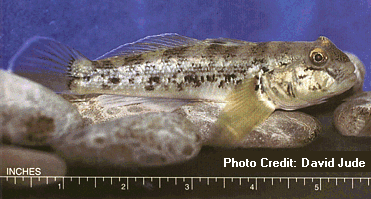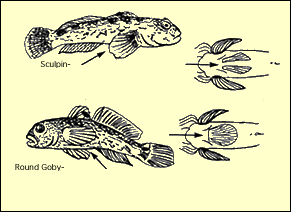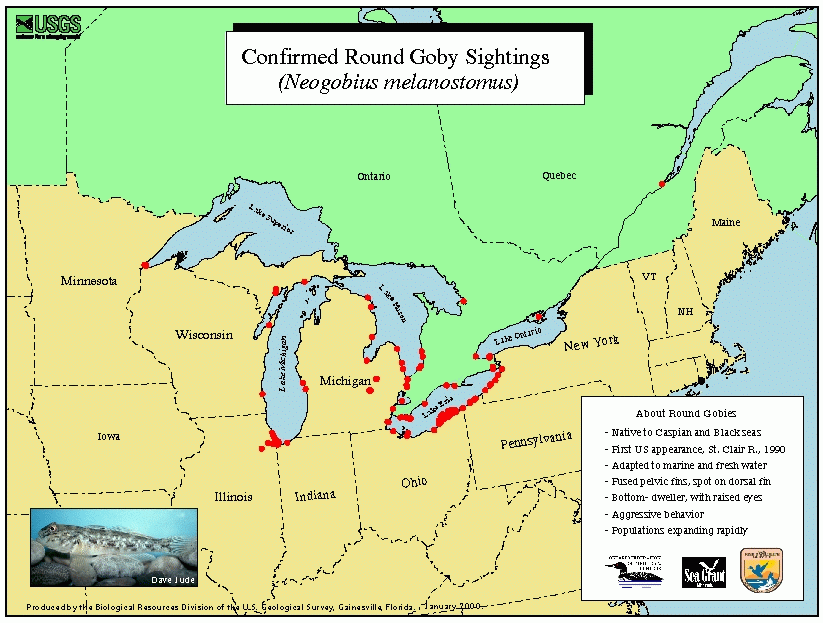 Common
Name: Round Goby
Common
Name: Round Goby
Scientific Name: Neogobius melanostomus
Classification:
Phylum: Chordata
Superclass: Osteichthyes
Class: Actinopterygii
Subclass: Neopterygii
Infraclass: Teleostei
Superorder: Acanthopterygii
Order: Perciformes
Suborder: Gobioidei
Family: Gobiidae
Sub-family: Goibionellinae
Identification:
 Round
gobies are small, bottom-dwelling (benthic) fish that generally attain
a length of 80-100mm (females) to 100-130mm (males) up to a maximum of
250mm. They have a soft, cylindrical body and large head with bulbous
eyes and large lips. Typically, they are grayish brown with mottled black
spots and have a single, large black spot on their spiny dorsal fin, though
a large percentage of round gobies found in Lake Erie do not display the
dorsal marking. Spawning males are dark gray.
Round
gobies are small, bottom-dwelling (benthic) fish that generally attain
a length of 80-100mm (females) to 100-130mm (males) up to a maximum of
250mm. They have a soft, cylindrical body and large head with bulbous
eyes and large lips. Typically, they are grayish brown with mottled black
spots and have a single, large black spot on their spiny dorsal fin, though
a large percentage of round gobies found in Lake Erie do not display the
dorsal marking. Spawning males are dark gray.
Gobies are similar in appearance to native sculpins (Cottus bairdi), but have a distinctive, fused pelvic fin that they use to secure themselves to rocky or pebbly bottom substrate (see figure). Round gobies are also similar to their relative and concurrent invader of the Great Lakes, the tubenose goby (Proterorhinus marmoratus), but, while both display the fused pelvic fin, round gobies lack the namesake prominent nostrils of the tubenose.
Original Distribution: Members of the Gobiidae family are found throughout the world in fresh and salt water environments. Sixty-eight species are native to the Pacific and Atlantic coasts of the United States. The Round goby is native to the Caspian Sea, northern Black Sea, Sea of Azov, and their tributaries. They generally inhabit shallow areas of the sea and lower to middle reaches of rivers in brackish or fresh water, but have been known to overwinter in water as deep as 60m.
Click to enlarge
 Current
Distribution: Round gobies are currently found in all five of the Laurentian
Great Lakes, as well as in Lake St. Clair, the St. Clair River, the Detroit
River and the St. Lawrence River. There have also been inland sightings
in the Shiawassee River near Fenton, Michigan, the Cal-Sag Canal south
of Chicago, and the Chicago River as well as documented reports of a concurrent
invasion in Poland's Gulf of Gdansk. Additional invasions have been reported
in the Moscow River, Kuybyshev Reservoir on the Volga River, and the Aral
Sea. Round gobies were eventually eliminated from the Aral Sea some time
in the late 1980s when its salinity rose dramatically as a result of diversion
and evaporation.
Current
Distribution: Round gobies are currently found in all five of the Laurentian
Great Lakes, as well as in Lake St. Clair, the St. Clair River, the Detroit
River and the St. Lawrence River. There have also been inland sightings
in the Shiawassee River near Fenton, Michigan, the Cal-Sag Canal south
of Chicago, and the Chicago River as well as documented reports of a concurrent
invasion in Poland's Gulf of Gdansk. Additional invasions have been reported
in the Moscow River, Kuybyshev Reservoir on the Volga River, and the Aral
Sea. Round gobies were eventually eliminated from the Aral Sea some time
in the late 1980s when its salinity rose dramatically as a result of diversion
and evaporation.
Site and Date of Introduction: The earliest confirmed sighting of a round goby in the Great Lakes drainage occurred on June 28, 1990 when one was taken by a U.S. angler on the St. Clair River in Canadian waters off Sarnia, Ontario. During the winter of 1990-1991, 9 of 11 round gobies found near the Belle River Power Plant in Michigan were identified as young-of-the-year, indicating that spawning had occurred some time in the previous season.
Timeline of Introduction
and Spread
1990 First
recorded sighting of round goby in Great Lakes region (St. Clair River)
1993 First
sighting in Lake Michigan (Calumet River), Lake Erie (Grand River Harbor,
Ohio), and Detroit River
1994 First
sighting in Lake Huron (Goderich, Ontario)
1995 First
sighting in Lake Superior (Duluth, Minnesota) and the Welland Canal (Port
Colborne, Ontario)
1996 First
inland sighting (Shiawasee River in Michigan)
1997 First
sighting in Lake Ontario
Mode(s) of Introduction: The round goby was most likely transported from its native habitat in the Black or Caspian Sea to the Great Lakes in the ballast water of an oceangoing freighter. Its rapid spread throughout the Great Lakes basin likely indicates either multiple introductions or continued spread via lakegoing freighters or both.
Reason(s) Why it has Become Established: The round goby has turned out to be ideally suited to transport and establishment in the Great Lakes. They are remarkably tolerant to wide ranges of salinity and oxygen levels, a characteristic that has served them well, apparently, in both transport via ballast tanks and establishment in the degraded habitats of near-shore Great Lakes environments. Gobies are also uniquely suited to hunting in the dark. Superficial neuromasts in their body make it possible for gobies to detect movement with greater sensitivity than other benthic fish in the Great Lakes. This gives them an advantage over competitors in locating prey in dark or murky water. It also likely contributed to their ability to survive transport in the darkness of a ship's ballast tanks.
Round gobies are also extremely prolific, iteroparous (repeat spawners), and aggressively defend their nests, thereby limiting the access of native species that spawn in similar areas to prime habitats. Females in the Great Lakes have been known to spawn as often as three times per season, whereas other native benthic fish spawn only one time, and to lay as many as 5,000 eggs at once. The impact of these reproduction characteristics is reflected by the fact that in 1989, no round gobies were recorded caught in the St. Clair River delta, but by the spring of 1990, they composed the bulk of the angling catch.
While males spawn only once in their lifetime, they are known to guard nests containing the eggs of more than one female. Eggs are large (approx. 4mm x 2mm), making them difficult for many potential predators to ingest. In addition, newly hatched gobies do not pass through a planktonic phase, which also limits the number of potential predators.
Round gobies are voracious feeders and consume a wide variety of benthic organisms, most notably the zebra mussel (Dreissena polymorpha)--a very abundant food source in the Great Lakes. In addition, it is the largest benthic fish in the Great Lakes and displays extremely aggressive behavior towards native intruders to feeding and nesting sites, making it a very successful competitor for limited resources within its habitat range.
Ecological Role: In its native habitat, the round goby poses no identifiable threat to the populations of any other species, most likely because it has co-evolved with other natives over time. It is actively and commercially fished in eastern Europe, although the total catch has decreased in recent years, likely as a result of habitat degradation. In addition, round gobies are prey for sturgeon, pike, and pikeperch--all commercially important species in the Black and Caspian Seas.
In the Great Lakes, round gobies feed on other benthic organisms including chironomid larvae, the eggs of other fish and gobies, small fish (sculpins, darters and young-of-the-year gobies), crustaceans, and molluscs it finds near the bottom. Most notably, round gobies are known to consume zebra mussels, another prolific Great Lakes invader, in large quantities. Gobies are, in turn, preyed upon by larger sport fish such as largemouth bass, smallmouth bass, and yellow perch.
Benefit(s): The only benefit attributed to the round goby is that it is a voracious consumer of another significant Great Lakes invader, the zebra mussel (Dreissena polymorpha). In one laboratory study (Ghedotti, et al,1995), round gobies of average (80 - 110 mm) length were able to consume zebra mussels 100 - 120mm in size and ate an average of 36 zebra mussels per day. Gobies also seemed to show a significant preference for zebra mussels over native clams and snails when presented with varying distributions of clumped and unclumped prey over different substrates. However, because gobies do not have a swim bladder and are negatively buoyant, prey attached to an aquarium wall just 20cm off the bottom appeared safe from round gobies.
Threat(s): Round gobies present a wide range of threats to the Great Lakes. First, they actively compete with native species for limited food resources and nesting habitats. Their aggressive behavior, large size, and prolific reproduction have enabled round gobies to successfully displace or diminish once large populations of mottled sculpins, darters, and logperch. Sculpins, in particular, share feeding, spawning, and nesting habitat preferences with round gobies, but they have been observed being forced into increasingly deeper habitats throughout the Great Lakes, likely as a result of the many advantages that gobies hold over them.
Gobies are highly aggressive when defending their nest and have been known to kill and eat other fish when doing so. They are also able to out-compete most other benthic fish for food. Their size, behavior and physiology (superficial body neuromasts) places them at a distinct advantage over Great Lakes natives for a wide range of prey. They are also presumed predators on the eggs of other benthic fish, thus diminishing the populations of their competition at the same time that they are able to out-compete their rivals.
Finally, because some piscivorous species are known to feed on round gobies, most notably largemouth bass, smallmouth bass, and yellow perch, these fish are indirectly consuming the toxicity load of the zebra mussels that round gobies are known to consume. As gobies proliferate and displace other prey for piscivores, these fish will be consuming a greater load of PCBs, mercury, and other ecotoxins, which are then made available to humans who consume Great Lakes sport fish. As benthic organisms, round gobies also feed on the bottom and disturb the upper sediment layers. When they do, the toxins stored there are re-suspended into the water column and made available to the rest of the food chain, though this impact is likely less of a threat than its role as a bioaccumulator.
Control
Level Diagnosis: High priority
Because it is already well
established in the Great Lakes, most efforts have focused and should continue
to focus on preventing its spread. While the round goby is not threatening
any endangered species in the Great Lakes, but its immediate threat to
lake trout populations in the Mississippi watershed is potentially very
significant, as are its potential threat to similar fish in the Hudson
River watershed. In addition, its impact on the greater ichthyfauna native
of these areas is largely unknown. However, its observed behavior
gives it the capability to actively and aggressively compete with species
such as bluegill and smallmouth bass populations for nesting habitat and
food resources in both the Mississippi and Hudson Rivers. It is important
to note that a major food source for round gobies, the zebra mussel, is
already well established in both river systems, thus laying the foundation
for rapid spread if gobies are introduced.
Control Method: Thus far, control strategies have been limited to preventing the round goby from escaping the Great Lakes via the Chicago and Calumet Rivers to the Illinnois and Mississippi River watersheds. The most common control methods have employed either electronic barriers (fences and mats) or piscicides or a combination of both. The effectiveness of these methods, however, has yet to be determined. Public education campaigns are also being conducted in almost every state and province in the U.S. and Canada that border the Great Lakes. These remind boaters to empty their bait buckets on land before moving from one watershed to another, that it is illegal to use round gobies as bait (or even to possess live gobies), and to wash boats and motors to help minimize the continued spread of the round goby and other Great Lakes Invaders.
References:
Corkum, Lynda D., Andrew
J. MacInnis, and Robert G. Wickett, 1998, Reproducttive Habits of Round
Gobies, Great Lakes Research Review, 3(2):13-20.
Charlebois, Patrice M., et al, 1997, The round goby, Neogobius melanostomus (Pallas), a review of European and North American literature, Illinois-Indiana Sea Grant Program and Illinois Natural History Survey, INHS Special Publication No. 20, 76 pp.
Crossman, E. J., E. Holm, R. Cholmondeley, and K. Tuininga, 1992, First Record for the Rudd, Scardinius erythrophthalmus, and Notes on the Introduced Round Goby, Neogobius melanostomus, Canadian Field-Naturalist, 109(2):206-209.
Ghedotti, Michael J., Joseph C. Smihula, and Gerald R. Smith, 1995, Zebra Mussel Predation by Round Gobies in the Laboratory, Journal of Great Lakes Resources, 21(4):665-669.
Jude, David J., R. H. Reider, and G. R. Smith, 1992, Establishment of Gobiidae in the Great Lakes Basin, Canadian Journal of Fish and Aquatic Science, 49:416-422.
Jude, David J., 1997, Round Gobies: Cyberfish of the Third Millennium, Great Lakes Research Review, 3(1):27-34.
Morrison, Heather, D. Michael Whittle, G. Douglas Haffner, 2000, The Relative Importance of Species Invasions and Sediment Disturbance in Regulating Chemical dynamics in Western Lake Erie, Ecological Modeling, 125(2000): 279-294.
Skora, K. E., 1997 (October 8, 2001), Neogobius melanostomus, In: Baltic Research Network on Ecology of Marine Invasions and Introductions, S. Olenin and D. Daunys (eds.), http://www.ku.lt/nemo/mainmemo.htm.
Wicket, Robert G., and Lynda D. Corkum, 1998, Nest Defense by the Non-indigenous Fish, the Round Goby, Neogobius melanostomus(Gobiidea), on a Shipwreck in Western Lake Erie, Canadian Field-Naturalist, 112(4):653-656.